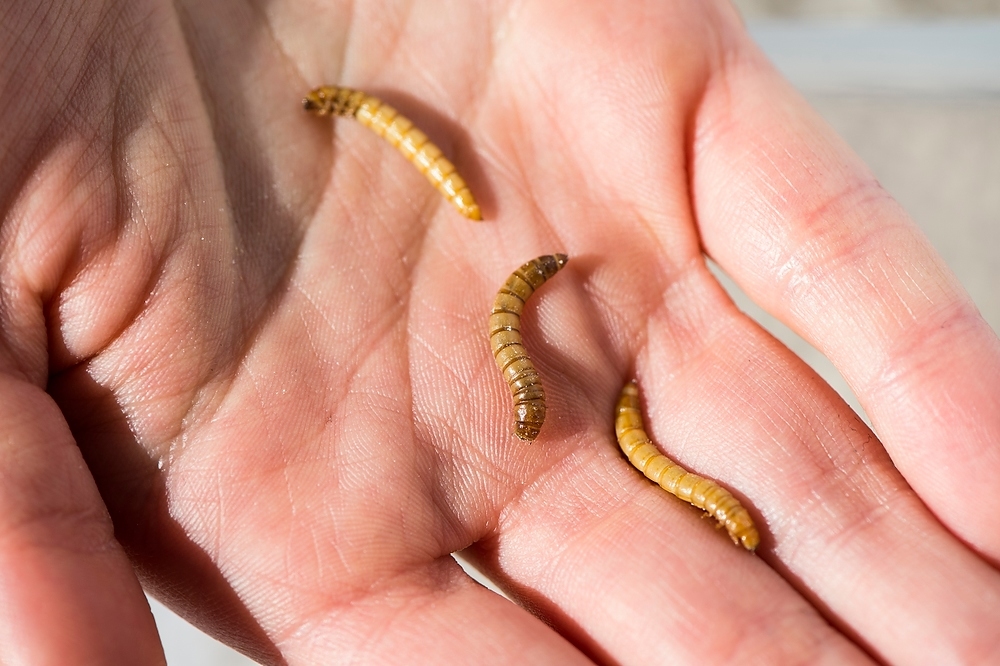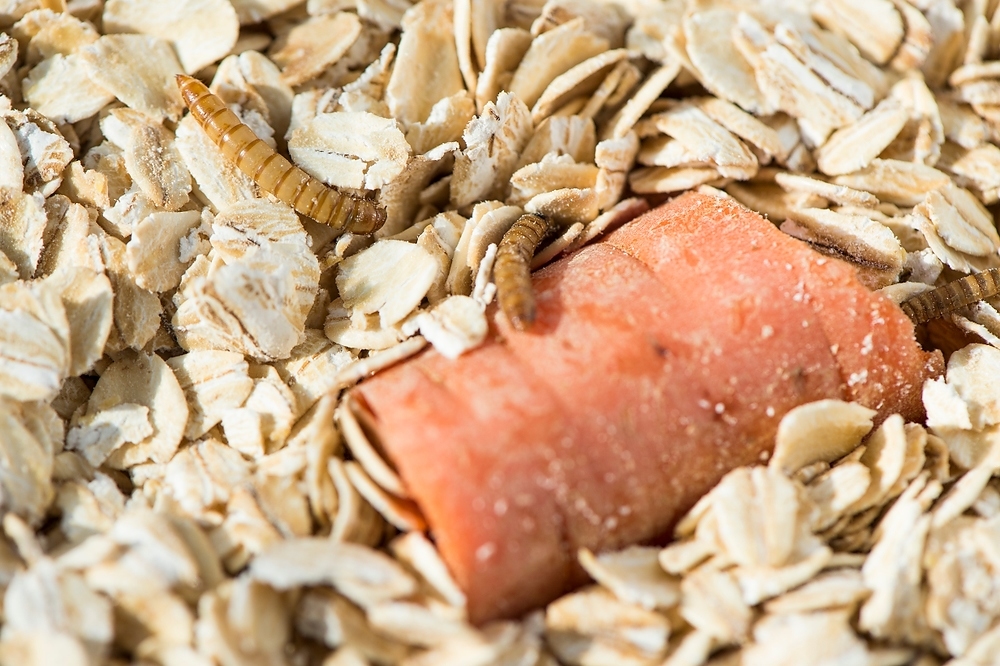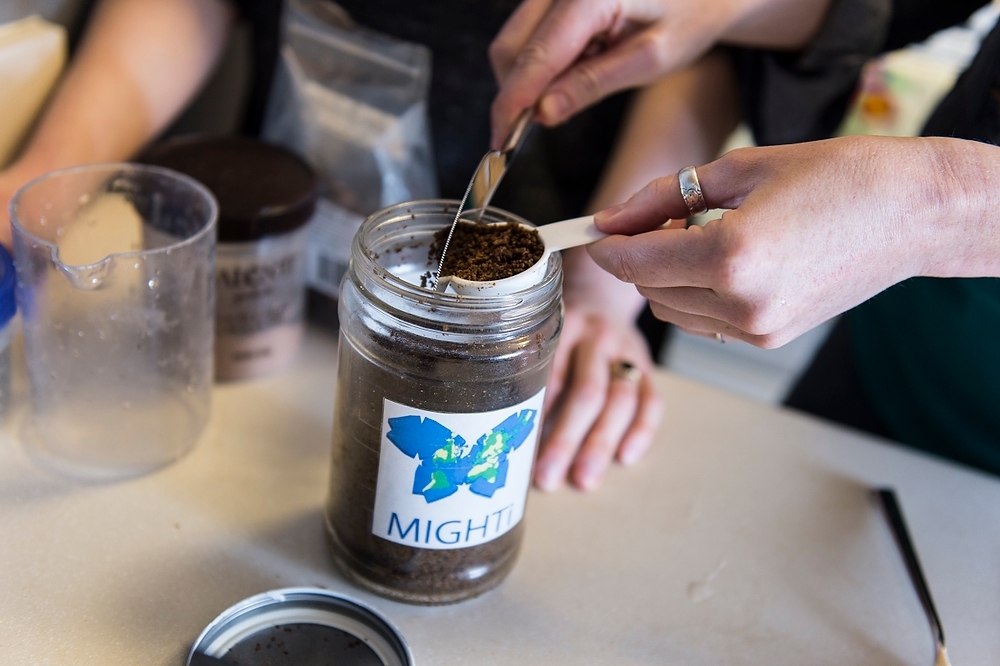Could squirmy livestock dent Africa’s protein deficit?

Rachel Bergmans, left, and Valerie Stull make a nutritious shake using roasted and ground mealworms. The two are researching the use of such mealworms as an inexpensive microlivestock that can provide an easy source of protein.
As a cheap and easy source of protein for humans, it might be hard to beat the mighty mealworm.
Consider:
- The capacity of insects like mealworms to convert feed to body mass exceeds that of traditional livestock such as beef by orders of magnitude.
- Mealworms are 100 percent edible, whereas only about 40 percent of a cow or 55 percent of a chicken can be consumed.
- Microlivestock such as mealworms take up little space and require little water.

Microlivestock such as mealworms take up little space and require little water.
- Mealworms can be reared on less feed and using organic byproducts such as corn leaves and stalks.
- Because they are exothermic, obtaining warmth from the local environment, mealworms do not use energy to maintain a constant body temperature the way conventional livestock do, and cultivated insects produce less greenhouse gases.
“Mealworms are so easy to farm. You can do it in a plastic bucket,” says Valerie Stull, a University of Wisconsin–Madison Nelson Institute for Environmental Studies graduate student who does just that in her home kitchen to provide an extra dash of protein to cookies, banana bread or a stir-fry.
But Stull and her collaborator — fellow UW graduate student Rachel Bergmans, who likes her mealworms powdered as a protein supplement for smoothies — are just practicing what they are beginning to preach: insects, and mealworms in particular, are an overlooked, healthful, economically viable and sustainable source of nutrition for people.

Mealworms are pictured feeding on a diet of oats and a carrot.
“We want everyone to see the benefits of insect consumption, not just from a nutritional standpoint, but a climate standpoint,” says Bergmans, who is pursuing her doctorate in the Department of Population Health Sciences in the UW–Madison School of Medicine and Public Health. “Farming insects can be a side stream for existing agricultural activities.”
Stull and Bergmans are working to introduce highly productive kits for farming mealworms to regions such as sub-Saharan Africa where eating insects is already culturally palatable. With the help of $25,000 in prize money from the Howard G. Buffett Foundation’s annual Agricultural Innovation Prize, Bergmans and Stull have begun to establish a presence in Zambia, where they plan to distribute their kits along with microfinancing opportunities for insect farming to rural women’s cooperatives. The pair’s project was also selected this week as the winner of UW-Madison’s Climate Quest competition, which will support a pilot project beginning this fall.
“What we’re trying to do is introduce the farming of insects through these kits and culturally appropriate training,” Bergmans explains. “We want to see if farming mealworms can be done at the local level in Zambia in a sustainable way. Our interest is in partnering with these communities.”

Bergmans and Stull have created MIGHTi (The Mission to Improve Global Health Through Insects), a startup business focused on producing edible mealworm protein powder.
Stull and Bergmans are working with the Oakland, California-based company Tiny Farms to develop their kit and optimize microlivestock habitat, rearing and feed formulation. Although still in development, a kit might include a rearing enclosure, a solar dryer, and a rocket stove to facilitate quick-turnaround processing.
The ultimate design of the kit, says Stull, will ideally use local materials and resources. Corn stover, the often unutilized stalks and leaves of maize, is an abundant resource in Zambia that could be turned to mealworm food. Stull is conducting a feeding study in UW–Madison’s Department of Entomology to better assess that possibility. The two graduate students are also investigating production optimization and have formed a company, MIGHTi or Mission to Improve Global Health Through Insects.
Try these protein-packed mealworm recipes
“We see potential down the road for the insect farming to become an extra source of income for families,” Bergmans says, noting that farmed insects can not only be a source of protein for human diets, they can also feed livestock such as goats, chickens and farm-raised fish.
On their forays to Zambia, Stull and Bergmans have begun to conduct informal market research to better assess their chances of success: “We get really interesting and mixed reactions,” says Stull. “People have legitimate questions: Is there a market? What does it taste like? Will the mealworms eat my crops?”
Taste tests may be the next phase of market research, say Stull and Bergmans. They are, in fact, planning a spring tasting event on the UW–Madison campus to highlight the benefits of entomophagy (eating insects) and raise funds for scholarships in the Department of Entomology.
Subscribe to Wisconsin Ideas
Want more stories of the Wisconsin Idea in action? Sign-up for our monthly e-newsletter highlighting how Badgers are taking their education and research beyond the boundaries of the classroom to improve lives.



